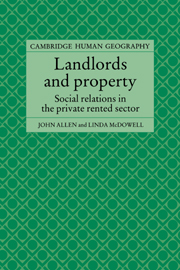Book contents
- Frontmatter
- Contents
- List of figures and tables
- Preface
- 1 Introduction
- 2 Private landlords: the anatomy of uneven decline
- 3 The structure of private landlordism
- 4 Research design and methods
- 5 Landlords in profile: an intensive survey
- 6 Landlords in the inner city: an extensive survey
- 7 Political ideologies and private rental policies
- Policy postscript
- Appendix 1 Selecting the landlord sample from housing waiting list records
- Appendix 2 Who was rehoused?
- References
- Index
4 - Research design and methods
Published online by Cambridge University Press: 17 September 2009
- Frontmatter
- Contents
- List of figures and tables
- Preface
- 1 Introduction
- 2 Private landlords: the anatomy of uneven decline
- 3 The structure of private landlordism
- 4 Research design and methods
- 5 Landlords in profile: an intensive survey
- 6 Landlords in the inner city: an extensive survey
- 7 Political ideologies and private rental policies
- Policy postscript
- Appendix 1 Selecting the landlord sample from housing waiting list records
- Appendix 2 Who was rehoused?
- References
- Index
Summary
In the preceding chapter we outlined our critique of the existing classification of the structure of private landlordism and proposed a new classification. In the succeeding chapters we present the results of empirical research into the structure of landlordism in two inner London boroughs – Hackney and Islington – at the end of the 1970s and in the early 1980s, followed by a chapter that tackles the difficult question of policy recommendations to effect change in this sector of the housing market. In this chapter we outline the methods that we adopted in the empirical research. Before doing so, we wish to point out that in this type of social science research there are important interconnections between classification, empirical research and policy recommendations. Despite presenting the chapters in this order, the different processes are interconnected and we found it difficult to separate them completely.
In fact, the chapters follow a ‘logic’ of presentation rather than the overlapping sequence of our method of working. The reconceptualisation of the workings of the private rented housing market and those who organise and shape it did not take place in some autonomous realm separate from or prior to submersion in empirical detail. Working with a selection of secondary sources such as the publications of the British Property Federation, the Small Landlords Association, Shelter, government surveys, in particular Paley's Attitudes to Lettings (1978), and a number of academic sources, we built up a tentative understanding of types of landlords operating in the market.
- Type
- Chapter
- Information
- Landlords and PropertySocial Relations in the Private Rented Sector, pp. 59 - 73Publisher: Cambridge University PressPrint publication year: 1989



